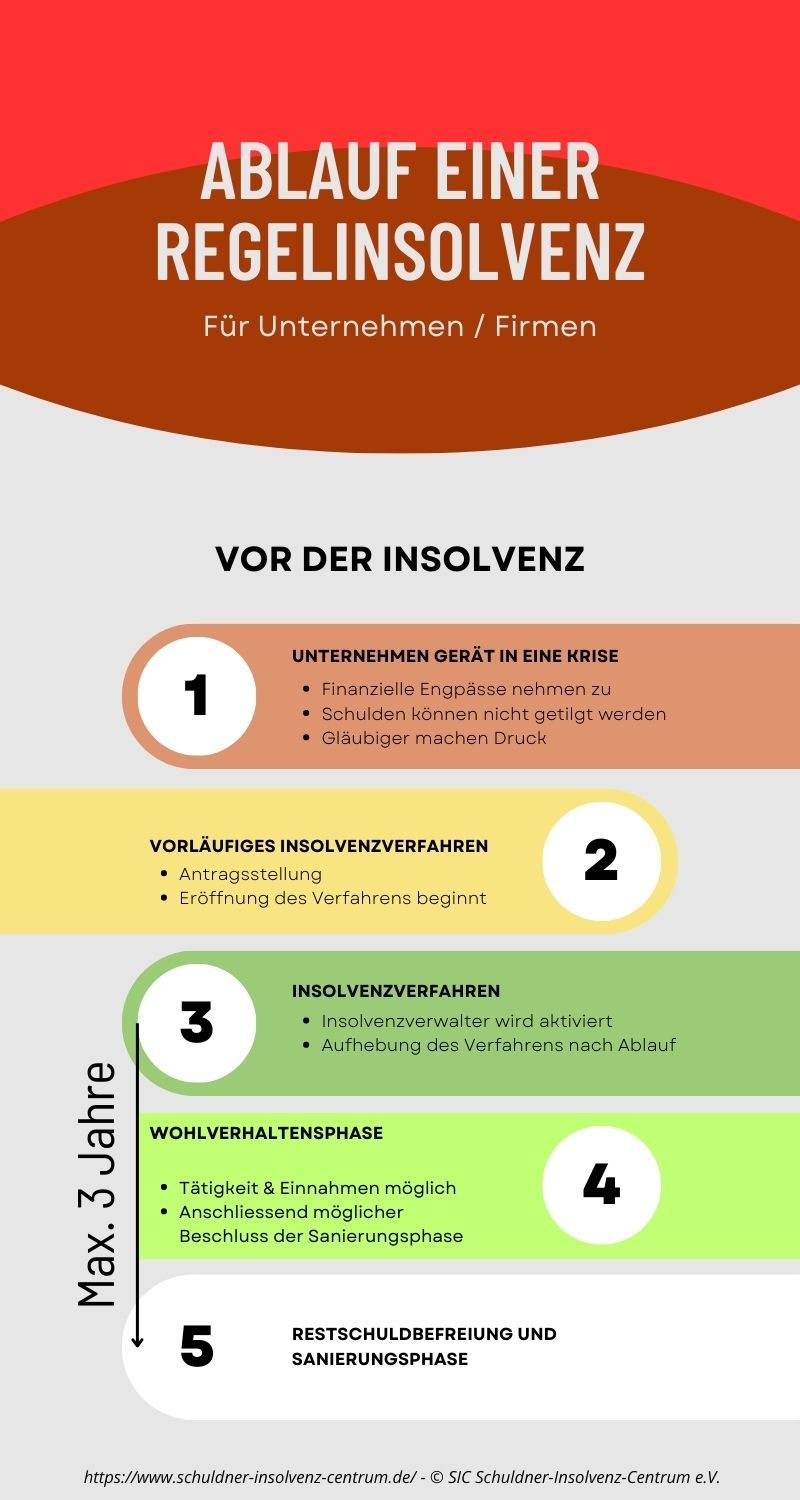standard insolvency
Standard insolvency for companies in 2025
- Remaining self-employed in a standard insolvency as an opportunity
- When must standard insolvency proceedings be initiated?
- Where must the standard insolvency application be filed?
- Tasks of the company in a standard insolvency - quick overview
- All details about the process of standard insolvency
- Process of standard insolvency as an infographic for overview
- Standard insolvency: First requirements
- Debt relief through standard insolvency is possible and sensible under the following conditions
- Process and Duration of Regular Insolvency
- The application for standard insolvency at the insolvency court
-
Advantages and Disadvantages of Standard Insolvency
Remaining self-employed in a standard insolvency as an opportunity
Self-employment can continue on the side. However, the insolvency administrator must be given a plausible explanation of how this will not lead to further debts. Once approved, it is not a problem and is even desirable to be able to reduce debts through self-employment.
Continuing or starting self-employment ideally increases the chance for creditors to recover part of their claims.
Corporate insolvency is also a standard insolvency . In the case of legal persons or companies (GmbH, AG, UG), insolvency proceedings end with a restructuring (continuation) or alternatively with a liquidation (dissolution).

When MUST standard insolvency proceedings be initiated?
When companies become insolvent. Or when Self-employed people with more than 19 creditors become insolvent . In this case, private insolvency for self-employed people is not possible.
Where must the standard insolvency application be filed?
The insolvency application must be submitted to the insolvency court responsible for your region . In contrast to consumer insolvency, it is not necessary to attempt to reach an out-of-court settlement with creditors beforehand .
Important: Professional advice from a lawyer or insolvency consultant is recommended in advance. There is also the option of taking out protection against the costs of filing for insolvency . This allows you to reduce serious risks in advance, such as " rejection of insolvency due to lack of assets ".
Who is entitled to apply for standard insolvency?
The special thing about standard insolvency is that both parties are entitled to apply.
On the one hand, there are partnerships (OHG, GbR, KG…) and corporations (GmbH, AG, UG), freelancers and also self-employed people .
These parties are creditors and debtors . As already explained with regard to the obligation to file for insolvency, consumers are not obliged to file for insolvency if there is a reason for insolvency.
Tasks of the company in a standard insolvency - quick overview
- Preparation of documents.
- File an application with the insolvency court.
- appointment of an insolvency administrator.
- convened a creditors' meeting.
- asset realization and debt settlement.
These are the three steps of the standard insolvency procedure
- opening proceedings
- The actual insolvency proceedings
-
The conclusion of the proceedings
All details about the process of standard insolvency
Normal insolvency lasts between 3 and 6 years. An insolvency procedure ends with the restructuring or liquidation of the company. In order to open insolvency proceedings , an application must be submitted to the insolvency court. There must be a reason for insolvency.
Process of standard insolvency as an infographic for overview:

Standard insolvency: First requirements
The opening of insolvency proceedings must be carried out by means of a standard insolvency application.
The insolvent company or the self-employed person can apply for standard insolvency. Creditors are also entitled to apply.
Insolvency: The debtor is unable to pay outstanding debts. He may have stopped making payments.
Debt relief through standard insolvency is possible and sensible under the following conditions:
If there is no possibility to pay off debts due to insolvency – debts can no longer be repaid.
Imminent insolvency also makes standard insolvency sensible. Section 18 sentence 2 of the Insolvency Code (InsO) assumes “a forecast period of 24 months ”.
In case of over-indebtedness: The debtor's assets are not sufficient to pay all liabilities. If the continuation of the company in the next twelve months is considered extremely unlikely.
In the case of self-employment
A consumer insolvency would then be the more appropriate type of procedure
- Your main place of residence should be in Germany .
- At the time of opening the standard insolvency proceedings, this is a prerequisite ( Section 2 InsO ).
-
After the first appointment with the insolvency administrator, a move abroad can take place if desired.
Rare alternatives and exceptions
There are more than 19 creditors from a self-employment (which was previously practiced) ( Section 305 para. 1 InsO )
The insolvency court determines the possible start of standard insolvency:
A consumer insolvency would then be the more appropriate type of procedure
- Your main place of residence should be in Germany .
- At the time of opening the standard insolvency proceedings, this is a prerequisite ( § 2 InsO ).
-
After the first appointment with the insolvency administrator, a move abroad can take place if desired.
Duration of standard insolvency:
This usually takes one to two years . This depends on the effort required to check all business documents , as well as the amount of debt and remaining capital. This is where the entire insolvency procedure ends for the respective companies // corporations.
The application for standard insolvency at the insolvency court:
This must be signed by at least one member of the responsible “representative body” (e.g. CEO, board member…) or by a creditor.
Obligations during this so-called good conduct phase are:
>> Standard insolvency has been applied for and the three-year period of good conduct begins on the day the proceedings are opened . During this time, the obligation to earn and report applies . The insolvency administrator must be informed immediately during this phase if income or living conditions change.
Opportunities for business activities and income:
From starting a business to continuing self-employment , there are opportunities to reduce debts faster even during regular insolvency.
Completion of the standard insolvency procedure:
Since October 2020, a maximum of 3 years . The previous procedures took 3, 5 or 6 years, depending on the rate of debt repayment (amortization).
Instead of using standard insolvency , you can try to reach an out-of-court settlement . If you successfully conclude this settlement, you will be debt-free much more quickly. On average, it only takes about three months until the settlement is concluded and you are debt-free. However, this only applies if you can make a one-off payment. If you agree to a enters into an out-of-court settlement with an installment agreement, it takes just as long as a regular insolvency.
If the requirements for an insolvency plan are met, you can become debt-free within a year. This is often more cost-effective in the long term.
What special features apply to employment contracts during the procedure?
The employment contracts continue to exist despite the opening of insolvency proceedings.
The employer's rights and obligations can be taken over by the insolvency administrator. The debtor only remains legally in the position of employer if the insolvency court orders self-administration. This can happen in the opening decision at the debtor's request and with the consent of the creditors.
employee's social insurance
The obligation to pay contributions to health, pension, nursing and unemployment insurance remains unaffected by the procedure. Contributions to accident insurance can in principle be waived, but only if the employees are released from work when the insolvency proceedings are opened until the employment relationships are terminated .
insolvency benefit from the employment agency
If the employer can no longer pay salaries , the employment agency will, under certain conditions, step in to pay the outstanding wages.
This takes place in the form of insolvency benefits according to Section 324 Paragraph 3 Sentence 1 SGB III .
If an insolvency event occurs (e.g. opening of insolvency proceedings, rejection of the opening of insolvency proceedings due to lack of assets), there is a claim to insolvency benefit for the last three months of the employment relationship (insolvency benefit period). Employees can apply for insolvency benefit from the responsible employment agency within a two-month deadline after the insolvency event .
The employment agency in whose district the payroll office responsible for the employer is located is responsible. The application can be submitted there up to a maximum of 2 months after the start of the employment .
Further information: https://www.arbeitsagentur.de/unternehmen/finanziell/insolvenzgeld
termination of employment relationships
The notice period is three months to the end of the month , unless a shorter notice period has been agreed; however, a longer notice period will be overridden by standard insolvency proceedings.
This shortened notice period applies to all longer notice periods, regulations and time limits or other types of agreements . Regardless of the legal or collective agreement basis of the respective employment relationship, the insolvency regulations take precedence.
Advantages and Disadvantages of Standard Insolvency

Advantages
- Self -employment and entrepreneurship can continue . For natural persons, continuing to work as a managing director can also make sense.
- Everything becomes more calculable because the maximum duration and also the money left to live on are fixed.
- The financial basis of life is protected by exemptions from seizure protected in the so-called P-account .
- Protection against creditors' claims . This means that reminders and enforcement notices are not sent by post. This is a great relief.
- A new financial start is possible: Standard insolvency allows indebted companies and businesses to make a new economic start after the procedure has been completed, as they are freed from most of their debts.
Disadvantages
- Insolvency announcements : Under insolvency announcements, everyone can see who is going through insolvency proceedings.
- Schufa entry : This will only be deleted three years after the discharge of residual debt .
- Public registration with SCHUFA entry: The fact that you are going through regular insolvency is entered in the insolvency register and is therefore publicly visible. This can have an impact on your reputation and creditworthiness . The entry is only deleted three years after the residual debt has been discharged .
- Loss of assets & attachments : During the insolvency proceedings, the insolvency administrator can realise the debtor's attachable assets to satisfy creditors. This can result in the loss of financial assets, such as real estate or vehicles.
- Lengthy process: Standard insolvency is a complex procedure that can take several years. During this time, the debtor is bound to certain requirements and obligations.
- Lower chances of getting credit: After a regular bankruptcy, it may be difficult to get credit or loans in the foreseeable future , as your creditworthiness may be significantly impaired.
Get to know us - Wolfgang Seelig and his team are personally there for you!
Frequently asked questions about insolvency advice and debt settlement
What is insolvency proceedings?
An insolvency procedure is (simply put) a legal procedure that a debtor can apply for if he has long-term financial problems. Upon application to the responsible district court, a procedure is opened that includes all debts and all assets and carries out debt relief with the help of an administrator appointed by the court. This procedure is subject to conditions and cooperation, but ultimately results in "debt relief" so that a new financial start is possible for the person affected. We would be happy to explain the possibilities and limitations in detail in the free initial consultation.
Can anyone open insolvency proceedings?
In principle, yes. However, there must be a financial situation that justifies such a procedure, ie current income and existing assets are no longer sufficient to meet payment obligations (over-indebtedness). The debts must also be higher than the costs of the procedure. An unpaid fitness membership alone usually does not meet this requirement.
What documents are required for a consultation?
- current income certificate(s) such as wage/salary certificate, approval certificate, pension certificate, allowance, etc. If you have multiple incomes, all income certificates/certificates are required (e.g. for supplementary benefits ALGII)
- possible child benefit notice
- all reminders and enforcement notices (yellow letters)
- Evidence of unpaid invoices
- Reminders, debt collection letters, letters from lawyers, etc.
NOTE: These documents do not have to be pre-sorted, we understand if you are overwhelmed by the situation and will open/sort your letters for you.
Are there different insolvency procedures?
Yes. On the one hand, there is the consumer insolvency procedure and on the other hand, there is the standard insolvency procedure. Both procedures are identical in that they both involve debt relief and debt forgiveness.
- The consumer insolvency procedure (VI) applies to all dependent workers (workers, employees, pensioners, unemployed, etc.) but also to former self-employed people who have fewer than 19 creditors. In this procedure, it is legally required that, before the application is submitted, a recognized and approved insolvency advice center attempts to reach an out-of-court settlement with the creditors and, if this fails, issues a so-called negative certificate for the specific case. We are such a body and can issue this certificate.
- The standard insolvency procedure (RI) is a procedure for self-employed persons and freelancers who are currently maintaining their self-employment or for former self-employed persons who have claims from employment relationships of former employees or more than 18 creditors. In this procedure, it is not mandatory to involve an insolvency advisory center, but our experience shows that by involving one (our) advisory center, the chances of success are higher and, above all, mistakes are avoided that could lead to the failure of the procedure.
What does “attempt at an out-of-court settlement” mean?
The law stipulates that an application for consumer insolvency must always be preceded by an attempt to reach an out-of-court settlement with all creditors by a recognized insolvency counseling agency. This means that the counseling agency must try to reach an agreement with all creditors. The basis of the debt settlement plan to be drawn up is the debtor's attachable income and assets, possibly also supplemented by voluntary payments.
What happens next in court?
If the application for consumer insolvency, supplemented by applications for discharge of residual debt and deferral of procedural costs, has been submitted to the court, the first step is to check whether all information and attachments are complete. The insolvency judge will then decide on the opening of the proceedings (in the "normal" case, a so-called opening decision will be made).
In the course of this, the court appoints an administrator/trustee who is subsequently the responsible contact person, who is also tasked with the realization of any assets that may exist, to whom the debtor is obliged to provide information and to be accountable, who reports to the court during the good conduct phase that follows, who ultimately also prepares the final report and thus enables the court to decide on the discharge of residual debt (debt forgiveness).
Will I also incur costs in the legal proceedings?
Yes. Insolvency proceedings incur costs on the part of the court (court and procedural costs) and costs for the administrator/trustee. As a precaution, an application for a deferral of costs should be made in case the insolvency estate is not sufficient to cover these costs.
How long does a consumer insolvency procedure take?
Since January 2021, consumer insolvency proceedings only take 3 years instead of the previous 6 years.
What can I do if I no longer have any documents relating to my debts?
We can provide you with forms that you can use to request information from Schufa, other credit agencies, the debtors' register and bailiffs. However, you must make the enquiry from the bailiffs. We will advise you on how best to organize this. Simply speak to us about it during the consultation.
Can you help me with a certificate according to § 850c paragraph 4 ZPO (P-account certificate)?
Of course! Simply fill out the pre-made form on our homepage under the item "P-Account" and you will receive your certificate within 3-4 working days.
SIC SCHULDNER-INSOLVENZ-CENTRUM EV
President: W. Seelig
Hauptstr. 115
D-70771 L.-Echterdingen (near Stuttgart Airport)
Tel.: +49 (0)711-933 42 115
Fax: 49 (0)711- 46914839
WhatsApp: 015732478936
SIC SCHULDNER-INSOLVENZ-CENTRUM EV
President: W. Seelig
Hauptstr. 115
D-70771 L.-Echterdingen (near Stuttgart Airport)
Tel.: +49 (0)711-933 42 115
Fax: 49 (0)711- 46914839
WhatsApp: 015732478936

Competent debt and insolvency advice in the greater Stuttgart area
Welcome to the website of the SIC Debtor Insolvency Center e. V. in Stuttgart. We are your contact for all questions about debt and insolvency. Regardless of whether you are facing insolvency proceedings privately or professionally - we will help you professionally. Discover our advisory services and initial information about your options. We are here to help you!"

About Us
Find out more about me and my team at SIC Debtor Insolvency Center e. V. Our expertise is based on personal experience and professional qualifications.

Contact us
Do you have questions about insolvency advice or do you need support? Contact us conveniently via WhatsApp, telephone or email. Our team is ready to help you. Don't hesitate to contact us!






